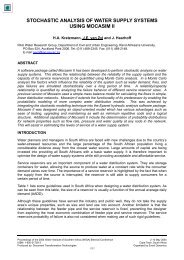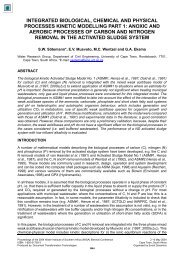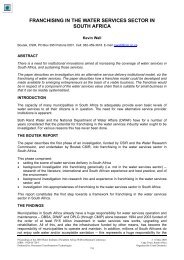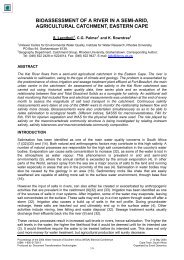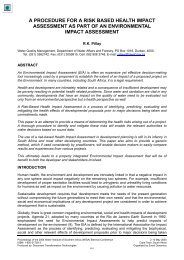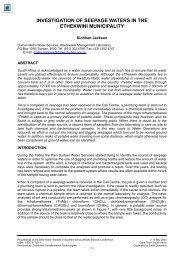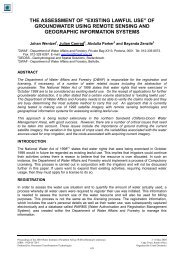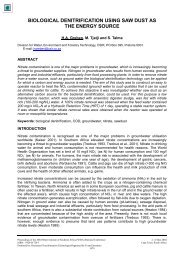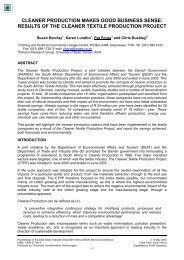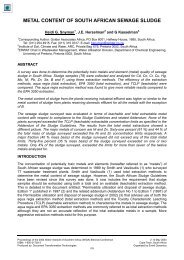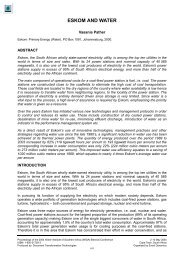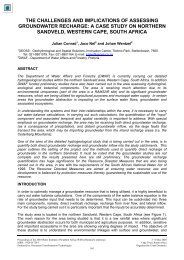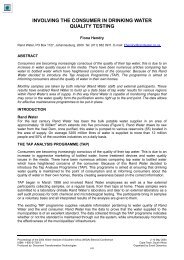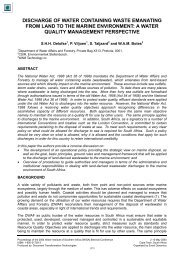eBook (pdf) - eWISA
eBook (pdf) - eWISA
eBook (pdf) - eWISA
Create successful ePaper yourself
Turn your PDF publications into a flip-book with our unique Google optimized e-Paper software.
i. Overview<br />
ii. Geophysical<br />
iii. Hydrology and Geohydrological<br />
iv. Ecology<br />
v. Climate<br />
vi. Land-use<br />
vii. Populated places<br />
viii. Tributaries<br />
ix. Dams<br />
x. Water Treatment<br />
xi. WastewaterTreatment<br />
Contents
Overview<br />
The Berg River rises in the Franschhoek and Drakenstein mountains. It flows<br />
northwards past Paarl, Wellington, Hermon and<br />
Gouda, where it is joined by the Klein Berg<br />
and Vier-en-Twintig rivers. The Berg River<br />
then flows westwards past Porterville,<br />
Piketberg, Hopefield and Velddrif to discharge<br />
into St. Helena Bay on the west coast.<br />
The Berg River drains an area of<br />
approximately 8 980 km2 and has a total<br />
length of about 285 km. It has nine major and<br />
seven minor tributaries, six of which were naturally perennial, namely the<br />
Franschhoek,Wemmershoek, Dwars, Klein Berg, Vier-en-Twintig and Matjies rivers.<br />
The Berg River flows into the Berg River estuary. The mouth of the estuary is in St<br />
Helena Bay, approximately 130 km north of Cape Town. The catchment area is<br />
approximately 7690 sq.km.<br />
The Berg River drains the western slopes<br />
of the Olifants River Mountains, the<br />
Winterhoek Mountains and the<br />
Drakenstein Mountains as well as the<br />
Swartland. The origin is at Franschhoek in<br />
the Franschhoek Mountains
Topography<br />
The Berg River rises in the Franschhoek and Drakenstein mountains at an altitude of 1500 m. It<br />
flows northwards past Paarl, Wellington, Hermon and Gouda, where it is joined by the Klein Berg<br />
and Vier-en-Twintig rivers. The river then flows<br />
westwards past Porterville, Piketberg and Velddrif<br />
where it finally discharges into St. Helena Bay on<br />
the west coast.<br />
The Berg River Catchment covers an area of<br />
almost 9 000 km2 and is the largest catchment in<br />
the Western Cape Province . Based on geographic<br />
and topographic characteristics, the catchment can<br />
be divided into three distinct areas, namely the<br />
broad, flat extensive western portion west of<br />
Moorreesburg and Koringberg, the river valley<br />
portion east of Koringberg to just south of Paarl,<br />
Berg River Valley - Paarl and the upper mountainous source area south of Paarl. Major<br />
towns in the western portion include Saldanha, Vredenburg and Hopefield while key towns in the<br />
central river valley area include Piketberg, Porterville, Paarl and Wellington. Franschhoek is found<br />
at the base of the Franschhoek Mountains some 6 km north east of the proposed Berg River Dam<br />
site. The total population of the catchment is in the order of 200 000, most of whom live in the<br />
urban areas.<br />
Much of the catchment area is flat, with an average topographical gradient between Paarl and the<br />
mouth of the Berg River at Laaiplek of 0.001. Topographically, a north-trending ridge of mountains<br />
(Piketberg, Swartberg) divides the catchment in two, with the Berg River flowing through a poort<br />
between Koringberg and De Hoek. Mountains that reach in excess of 1 000 m elevation flank the<br />
north trending valley in the eastern part of the catchment, including the Groot Winterhoek<br />
Mountains, Kasteelberg, Perdeberg, Paarl Mountain and the Wemmershoek Mountains<br />
The profile of the Berg River (from the origin near Franschhoek to the mouth at Velddrif) is<br />
illustrated below:
Geology<br />
The Berg River Catchment comprises sequences<br />
of rocks of the Malmesbury Group, the Cape<br />
Granite Suite, the Klipheuwel Group, the Table<br />
Mountain Group and younger Cenozoic sediments<br />
in the western part of the catchment. The<br />
Malmesbury Group and Klipheuwel Group<br />
essentially comprise soft, erodible rocks that form<br />
flat plains in low lying areas. In general, these<br />
areas have moderate to high agricultural potential.<br />
The Malmesbury Group is steeply folded along a<br />
north west striking axis (Visser 1989). These<br />
metasediments form part of the Saldania Subprovince and have been subdivided into three<br />
tectono-stratigraphic domains, i.e. the Tygerberg, Swartland and Boland domains. These domains<br />
are separated by two major north-northwesterly striking fault systems, namely the Franschhoek-<br />
Saldanha (Colenso Fault) and Wellington-Piketberg Faults (Visser 1989)<br />
Outcrops of Cape Granite Suite rocks occur in the<br />
west, south and south east of the catchment. This<br />
series of granitic plutons, of late Precambrian to<br />
early Cambrian age, intruded into Malmesbury<br />
Group. Older intrusions occurred between 610<br />
and 560 Ma, while the younger phase occurred<br />
between 540 and 500 Ma (Timmerman 1988). In<br />
places they form prominent features like the Paarl<br />
Mountain.<br />
The Table Mountain Group comprises hard resistant quartzitic sandstones that form the mountain<br />
ranges that flank the north-trending river valley in the east. The rocks have been folded and<br />
faulted, giving them their secondary water-bearing features.<br />
Upper Berg River: Table Mountain Group (quartzitic sandstone), Sandy<br />
sediments<br />
Upper Middle Berg River: Table Mountain Group (quartzitic sandstone), Malmesbury Group<br />
(shale), Cape Granite Suite, Sandy sediments<br />
Lower Middle Berg River: Table Mountain Group (quartzitic sandstone), Malmesbury Group<br />
(shale), Klipheuwel Group, Sandy sediments<br />
Lower Berg River: Table Mountain Group (quartzitic sandstone), Malmesbury Group (shale),<br />
Cape Granite Suite, Sandy sediments<br />
soils<br />
The siliceous Table Mountain Group (TMG) produces soils that are acidic and infertile.<br />
Soils derived from the Cape Granite are also more fertile and finer textured than those derived<br />
from the Table Mountain Group
Hydrology<br />
The Berg River has its source in the<br />
Drakenstein and Franschhoek Mountains<br />
south of Franschhoek and discharges into<br />
the Atlantic Ocean near Velddrif, some 285<br />
km away. Major tributaries of the Berg River<br />
include the Franschhoek, Wemmershoek,<br />
Dwars, Kompagnies, Klein Berg, and<br />
Twenty-four Rivers. A striking characteristic<br />
of the catchment is the low density of<br />
drainage channels in the western parts of<br />
the catchment underlain by unconsolidated<br />
sandy recent deposits. Significantly higher<br />
drainage densities are observed in the<br />
central and eastern parts underlain by weathered and fractured rocks, mostly of the Malmesbury<br />
and Table Mountain Group. Two major dams have been built in the catchment. The<br />
Wemmershoek Dam south east of Paarl has a surface area of 3 km 2 and a storage capacity of 66<br />
million m 3 . The Voëlvlei Dam west of Tulbagh covers an area of 15 km 2 and has a storage<br />
capacity of 170 million m 3 . Numerous smaller farm dams are found throughout the east part of the<br />
catchment. Total natural runoff from the Berg River Catchment amounts to 931 million m 3 /a. These<br />
three catchments make up only 7% of the total area of the Berg River catchment. The estimated<br />
size of the catchment area of the Berg River Dam is about 70 km2, which is less than 0.8% of the<br />
total area of the Berg River Catchment. DWAF (1993) estimated present-day annual runoff of the<br />
Berg River amounted to 682 million m3/a, with the modified flow attributed to direct abstraction<br />
from the river for irrigation, storage and abstraction for urban water supply, development of<br />
forestry within the basin, irrigation return flow, and releases from the Voëlvlei, Wemmershoek and<br />
Theewaterskloof Dams (the latter via the Berg River Syphon).<br />
Flow and quality characteristics of the Berg River<br />
have been severely modified by abstraction from<br />
the river and the release of some 17 million m3/a<br />
of summer irrigation water from the<br />
Theewaterskloof Dam into the upper Berg River at<br />
the Berg River Syphon upstream of the proposed<br />
Berg River Dam site (1993 data; current releases<br />
amount to between 50 and 60 million m3/a). This<br />
water is used to supply irrigators downstream as<br />
far as Zonquasdrift. Downstream of Zonquasdrift,<br />
irrigation water is released from Voëlvlei Dam. It is<br />
of interest to note that in the geological past, the Berg River flowed from Assegaaibos past the<br />
position of the present tunnel siphon, straight past Robertsvlei camp and northeast down the<br />
Roberts River into the Franschhoek River. A mountain landslide resulted in blocking the upper<br />
reaches of the Robertsvlei gap, thereby causing the river to change its course to the present<br />
course through the proposed Berg River Dam site (Forbes, Dick and Associates 2001).<br />
The Berg River catchment falls within the winter rainfall region of the south-western Cape. Rainfall<br />
in the catchment increases from west to east.
Overview<br />
Vegetation<br />
ECOLOGY<br />
UPPER BERG RIVER and TRIBUTARIES - Habitat integrity and water quality in the Berg River deteriorate<br />
downstream as a result of alien vegetation encroachment (Acacia sp.), the interbasin transfer of water and<br />
river modification. Urban and agricultural development affect the water quality at Franschhoek (municipal and<br />
wine farm effluent). The lack of environmental flow releases from Wemmershoek Dam results in a severely<br />
altered flow regime and habitat downstream<br />
UPPER MIDDLE BERG RIVER and TRIBUTARIES -River health is reduced in the tributaries as a result of<br />
alien vegetation infestation and agricultural development (river modification, water abstraction, runoff). Water<br />
quality and habitat integrity in the Berg River and lower reaches of these tributaries are reduced due to urban<br />
development.<br />
LOWER MIDDLE BERG RIVER and TRIBUTARIES- Diversion weirs in the Klein Berg and Vieren-Twintig<br />
rivers have altered flow patterns. Alien fish (bass and banded tilapia) are widespread and have led to the<br />
disappearance of indigenous fish (Berg River redfin and whitefish). River health is also reduced by the effects<br />
of agriculture (levees and pesticide residues). Water quality and habitat integrity near Tulbagh are poor.<br />
LOWER BERG RIVER and TRIBUTARIES- Farming practices (riparian vegetation removal, bed modification,<br />
water abstraction) and alien vegetation (black wattle, river gum) impact on the habitat integrity and flow of the<br />
rivers. Flow releases are made from the bottom of Misverstand Dam and reduce water quality. Alien fish<br />
(banded tilapia and carp) prey on or compete with indigenous fish.<br />
UPPER BERG RIVER: Fynbos (Sandstone, Alluvium, Afromontane Mires)<br />
UPPER MIDDLE BERG RIVER: Fynbos (Alluvium, Afromontane Mires, Sand, Sandstone), Renosterveld<br />
(Shale, Granite)<br />
LOWER MIDDLE BERG RIVER: Fynbos (Sandstone, Shale, Alluvium), Shale Renosterveld<br />
LOWER BERG RIVER: Fynbos (Sand, Sandstone, Alluvium), Renosterveld (Shale, Granite, Silcrete,<br />
Alluvium)
Temperature<br />
Climate<br />
The mean annual temperature varies between 16°C in the<br />
east to 18°C along the West Coast, with an average of<br />
16°C. Maximum temperatures are experienced in January<br />
(average daily max = 29,4°C) and minimum temperatures<br />
usually occur in July (average daily min = 4,5°C).<br />
Temperatures along the coast are a few degrees cooler<br />
than in the interior.<br />
Rainfall<br />
The majority of the rainfall occurs between the months of May and September and hence it is<br />
referred to as a winter rainfall region. Rainfall is of a frontal nature, generally moving from the<br />
Atlantic Ocean to the north-west over the Western<br />
Cape. The orographical influence of the high<br />
mountain ranges in the Cape Peninsula and on the<br />
eastern side of the water management area,<br />
introduces a large spatial variability in the mean<br />
annual precipitation (MAP). In the high lying areas of<br />
the Upper Berg River, the upper reaches of the<br />
Eerste River and the Steenbras River, the maximum<br />
mean annual precipitation exceeds 3 000mm per<br />
annum.<br />
In the lowlands, the precipitation is between 600mm and 400mm per annum, being greater in the<br />
small mountain outcrops and hills and reducing to<br />
300mm per annum in the north-west , where the Berg<br />
River flows into the sea. The average potential mean<br />
annual evaporation (measured by S-pan) ranges from 1<br />
400mm in the south to 1 700mm in the north.<br />
The Berg River Catchment experiences a<br />
Mediterranean climate with warm dry summers and<br />
cool wet winters. Rainfall is of a cyclonic nature,<br />
extending normally over a few days with significant<br />
periods of<br />
clear weather in between. Little rain falls during<br />
summer, with the rainy season extending from April<br />
through to October.
Agricultural<br />
Land-use<br />
Wine grapes: Viticulture is an important agricultural activity practice in the southern part of the<br />
Berg River catchment and centered around Paarl, Wellington and Franschhoek<br />
Wheat: The Swartland is one of the major wheat producing areas in South-Africa. The main<br />
centres are Malmesbury, Moorreesburg and<br />
Piketberg.<br />
Other: Deciduous fruit is the backbone of the<br />
economy in the Berg River catchment. North of<br />
Wellington, dryland grain farming and sheep<br />
farming predominate. Commercial pine forests<br />
occur near the headwaters, around Franschhoek.<br />
The major industries in the Berg River basin are<br />
agriculturally based and include wineries,<br />
canneries and other food processing factories.<br />
Nature Conservation, Reserves, Tourism
Industries<br />
Fishing: Velddrif, St Helena Bay<br />
KWV Industry
Populated PLACES<br />
Name Province District Municipality Population River or tributary<br />
Laaiplek WC West<br />
Bergrivier Berg<br />
Coast<br />
Velddrif WC West<br />
Coast<br />
Hopefield WC West<br />
Coast<br />
Moorreesburg WC West<br />
Coast<br />
Piketberg WC West<br />
Coast<br />
Riebeeck West WC West<br />
Coast<br />
Bergrivier Berg<br />
Saldanha<br />
Bay<br />
Swartland<br />
Bergrivier<br />
Swartland<br />
Gouda WC Boland Drakenstein<br />
Porterville WC West<br />
Coast<br />
Bergrivier<br />
Wellington WC Boland Drakenstein Berg<br />
Paarl WC Boland Drakenstein Berg<br />
Simondium WC Boland Drakenstein Berg<br />
Little Berg river,<br />
Tulbagh WC Boland<br />
tributary of the Berg<br />
River<br />
Franschhoek WC Boland Stellenbosch Berg<br />
Pniel WC Boland Stellenbosch<br />
De Hoek WC West<br />
Coast<br />
Swartland
Tributary Notes<br />
Tributaries<br />
Klein Berg River (from the Voëlvlei Dam)<br />
Vier-en-twintig-riviere draining the Groot Winterhoek Mountains.<br />
Krom River draining the Swartland between Piketberg and<br />
the Olifants River Mountains<br />
Boesmans River draining the Piketberg Mountains<br />
Soutrivier draining the Swartland west of Moorreesburg
Dams<br />
Wemmershoek Dam<br />
Max. Capacity: 58.7 mil.cub.m.<br />
Comments: The dam wall was completed in 1957, and is<br />
in the Wemmershoek River.<br />
Voëlvlei Dam<br />
Max. Capacity: 158.6mil.cub.m.<br />
Comments: The dam is supplied by diversion works from<br />
the Klein Berg, Vier-en-twintig and Leeu Rivers.<br />
Misverstand Dam<br />
Max. Capacity: 6.4mil.cub.m.<br />
Comments: East of Piketberg<br />
Berg River Dam<br />
Max. Capacity: 126.4mil.cub.m.<br />
Comments: The construction of the Berg River Dam (Berg<br />
Water Project) commenced in 2005. The dam is situated<br />
near Franschhoek in the upper catchment of the Berg<br />
River.
Erika Derelict Water Works<br />
Tulbagh Water Works<br />
Water treatment works
Moorreesburg<br />
Veldrif<br />
Piketberg<br />
Franschoek<br />
Wastewater treatment works<br />
Wemmershoek<br />
La Motte<br />
Pniel<br />
Tulbagh
REFERENCES<br />
STATE-OF-RIVERS REPORT- RIVER HEALTH PROGRAMME BERG RIVER<br />
SYSTEM - 2004<br />
Department of Water Affairs and Forestry, South Africa. 2004. Berg Water<br />
Management Area: Internal Strategic Perspective. Prepared by Ninham Shand<br />
(Pty) Ltd in association with Jakoet and Associates, Umvoto Africa and Tlou and<br />
Matji, on behalf of the Directorate: National Water Resource Planning. DWAF<br />
Report No P WMA19/000/00/0304.<br />
Berg River Baseline Monitoring Programme - Introduction to the Berg River<br />
Catchment; Groundwater and Hydrology DWAF Report No. P WMA<br />
19/G10/00/1807 Edited by: GEORDIE RACTLIFFE
This e-book may be copied and distributed to others, but may not be sold.<br />
This e-book must be fully referenced wherever it may be used.<br />
Copyright ©WAMTechnology CC. All Rights Reserved<br />
WAMTechnology, DeWagenweg, Stellentia Rd. Stellenbosch, 021 887 7161<br />
www.ewisa.co.za



